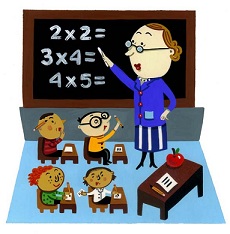I use the word "archetype" a lot in this blog, and most if not all of the posts will be tagged with the word. So I thought I'd spend a post talking about what an archetype actually is. To put it simply, an archetype is a pattern. It's a structure, or a form. And it’s invisible.
How does this work?
 If you take out a blank sheet of paper and draw a circle, you have drawn a pattern or a form we call "circle". We all recognize circles. We see them all over the place if we stop and look around the world. We see circles in the shape of the Sun, in the shape of coins, the wheels on cars, the top of most drinking glasses, the shape of CDs or record albums, the shape of the pupil in your eye, or in a merry-go-round. We recognize circles when we see them. Before we even draw a circle, we automatically know what a circle is. The same can be said for squares, triangles and rectangles. The main difference between those shapes that you see, and an archetype, is that the archetype is invisible. Wherever in your imagination you pulled the foundational image from which you drew your "circle" is the same place where all sorts of invisible patterns and shapes and forms reside. Archetypes are the foundational patterns of everything. If something exists, it originates in an archetypal form first. From the archetype of "circle" come all other circles.
If you take out a blank sheet of paper and draw a circle, you have drawn a pattern or a form we call "circle". We all recognize circles. We see them all over the place if we stop and look around the world. We see circles in the shape of the Sun, in the shape of coins, the wheels on cars, the top of most drinking glasses, the shape of CDs or record albums, the shape of the pupil in your eye, or in a merry-go-round. We recognize circles when we see them. Before we even draw a circle, we automatically know what a circle is. The same can be said for squares, triangles and rectangles. The main difference between those shapes that you see, and an archetype, is that the archetype is invisible. Wherever in your imagination you pulled the foundational image from which you drew your "circle" is the same place where all sorts of invisible patterns and shapes and forms reside. Archetypes are the foundational patterns of everything. If something exists, it originates in an archetypal form first. From the archetype of "circle" come all other circles.
 Looking at this another way, to connect it more to our lives, just like a blueprint consists of rectangles and squares and other shapes that combine to form the structure of a building, archetypes are the invisible structures of your life and of your soul. Archetypes are the invisible architecture of your soul. And these archetypes carry names that we resonate with in the same way we know what a circle is. Common archetypes include the Mother, the Father and the Child. When you hear those words you instantly recognize what they are. Similarly, it's easy to recognize the Teacher, the Artist, the Storyteller or the Clown. These are all archetypes. And in the way that many buildings together create a city, a combination of different archetypes create your life. You may be an Artist and a Teacher and a Mother. Or you may be a Student and a Prince and a Hero. If you are a Rebel and a Princess and a Hero (as seen, for example, in the movie “Whip It”), life gets very interesting and alive. See, when we embody a particular archetype we personalize it. If you are a Mother, you likely have a very nurturing nature, yet no two mothers nurture in exactly the same way. You mother the way you mother. Likewise, some teachers teach history, some teach math, and some teach theatre--and no two theatre teachers will teach theatre in the same way.
Looking at this another way, to connect it more to our lives, just like a blueprint consists of rectangles and squares and other shapes that combine to form the structure of a building, archetypes are the invisible structures of your life and of your soul. Archetypes are the invisible architecture of your soul. And these archetypes carry names that we resonate with in the same way we know what a circle is. Common archetypes include the Mother, the Father and the Child. When you hear those words you instantly recognize what they are. Similarly, it's easy to recognize the Teacher, the Artist, the Storyteller or the Clown. These are all archetypes. And in the way that many buildings together create a city, a combination of different archetypes create your life. You may be an Artist and a Teacher and a Mother. Or you may be a Student and a Prince and a Hero. If you are a Rebel and a Princess and a Hero (as seen, for example, in the movie “Whip It”), life gets very interesting and alive. See, when we embody a particular archetype we personalize it. If you are a Mother, you likely have a very nurturing nature, yet no two mothers nurture in exactly the same way. You mother the way you mother. Likewise, some teachers teach history, some teach math, and some teach theatre--and no two theatre teachers will teach theatre in the same way.
An important piece in understanding archetypes is that they are not literal. They are first and foremost invisible, which means you don’t need to dress in big shoes, a giant colorful curly wig and a round red nose in order to be a Clown. You don’t need to stand up in front of a literal classroom to be a Teacher. And you don’t need to be a particular age to be a Child. You don’t need to have literal children to be a Mother, and not all mothers carry within them a strong sense of the Mother archetype.
 In an even more complex way, archetypes combine to form larger patterns. Together, the Mother and Father and Child form the archetype of Family. A Teacher and Students combine to form the archetype of a Classroom, and Classrooms form a School. A School and a City Hall and a Post Office, a Grocery Store, other Businesses and some Homes might form the archetype of a City. A King and a Queen, a Prince and a Princess, a Knight, a Damsel, and a Fool create the archetype of the Court.
In an even more complex way, archetypes combine to form larger patterns. Together, the Mother and Father and Child form the archetype of Family. A Teacher and Students combine to form the archetype of a Classroom, and Classrooms form a School. A School and a City Hall and a Post Office, a Grocery Store, other Businesses and some Homes might form the archetype of a City. A King and a Queen, a Prince and a Princess, a Knight, a Damsel, and a Fool create the archetype of the Court.
In whichever manner you approach archetypes (on a personal level, a cultural level, or a historical level), essentially archetypes are recognizable because they are common to human experience. They are timeless. If you’ve ever learned something, you recognize the Teacher as well as the Student. If you've ever saved somone, you know the Rescuer. If you've ever birthed something, you know the Mother. If you’ve ever had your heart swell with passion, you know the Lover archetype.
To “see” archetypes is to see what is invisible within the visible, to see its essential makeup. And to see yourself and the rest of the world this way is to see symbolically rather than literally. Sometimes it can be like an upside-down reversal of how you typically see life, if you take the world in front of you literally. Yet, the advantage of learning to de-literalize and see the archetypal nature contained within anything (including yourself) is to bring a sense of soul back into life--into your life--and to see the enchanting and magical and eternal essence at the heart and soul of life itself.